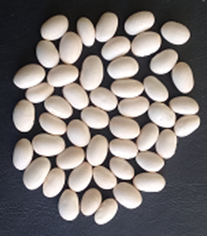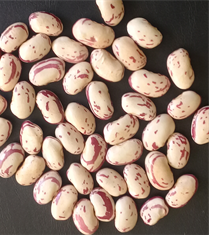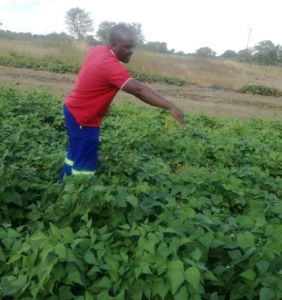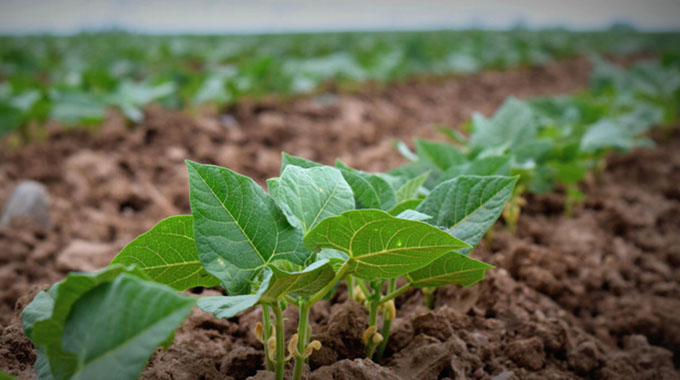SUPER DEMAND-DRIVEN BEAN CULTIVARS
CROP BREEDING INSTITUTE of DR&SS SCORES ‘TWO FIRSTS’
by
RELEASING TWO NEW “SUPER” DEMAND-DRIVEN BEAN CULTIVARS –
ONE FOR CANNING AND ANOTHER FOR NUTRITION


Protea for canning purposes NUA674 for nutrition
“The dry bean breeding team at the Department of Research and Specialist Services (DR&SS) in the Ministry of Lands, Agriculture and Rural Resettlement, led by Mr. Bruce Mutari has released one navy bean cultivar, Protea, and one sugar bean cultivar NUA674 for nutrition security. It is the first time that the country has its own canning bean cultivar, and similarly, the first time to release a sugar bean cultivar enriched with iron and zinc, says Dr Dumisani Kutywayo (Director – Crops Research Division under DR&SS).
The two cultivars are products of Demand/Market Led-Breeding, a principle of ensuring researchers develop cultivars in response to the needs of the consumers/market. Protea is readily available for uptake by both seed houses and the canning industry while NUA674 is under multiplication and will be available for seed houses in December 2018. Both cultivars were developed by DR&SS in collaboration with the International Center for Tropical Agriculture, CIAT, through the Pan-Africa Bean Research Alliance (PABRA) project in Zimbabwe with funding support from the Swiss Agency for development and Cooperation (SDC). The project, which has been in existence for more than 15 years is a partnership of CIAT-PABRA with DR&SS and other partners (Public, private and NGOs’). It seeks to improve food security, nutrition, incomes, natural resource base and gender equity for better livelihoods of smallholder households in Zimbabwe through ensuring:
- Wider utilization of dry bean products for food security
- Improved bean based products for nutrition security, and
- Increased trade of bean products in a gender equitable and sustainable way.
The two cultivars respond to the elements of the project as described below.
BACKGROUND ON THE NAVY BEAN CULTIVAR, PROTEA
Previously, Zimbabwe did not have a released canning bean cultivar. Farmers had been growing Ex-rico, a cultivar which was introduced, but never commercially released in Zimbabwe. The fact that Ex-rico was never commercially released in Zimbabwe meant there was no formal seed system to support its supply: seed was solely retained and exchanged among farmers. As a result, the cultivar has deteriorated in quality due to susceptibility to diseases, leading to low productivity although it is still found in some parts of Zimbabwe owing to lack of viable alternative options. This lack of official seed quality control had a three-fold effect on Ex-rico;
- varietal mixtures that reduced canning quality,
- buildup of seed borne diseases and,
- general loss of vigour resulting in low productivity.
These challenges have resulted in a significant reduction in the area under Ex-rico production, forcing processors to import about 60 percent of the canning grain from countries such as Ethiopia, South Africa, Zambia and Malawi. On a monthly basis, the canning industry imports more than 100 metric tonnes of navy bean grain worth US$120 000.00 in order to meet canning volume requirements. This depletes the scarce foreign currency and increases production costs to processors thus negatively influencing the final selling price of canned bean products to consumers in the country. Furthermore, the canning bean industry in Zimbabwe also experiences challenges with some of the imported consignments of navy bean which do not meet canning standards due mixtures of cultivars that have varying cooking profiles making them difficult to process during canning. Faced with these challenges, the canning industry had been considering abandoning navy bean canning line and replace it with other market classes of beans, which however do not have good canning attributes. Therefore, the commercial release of the improved navy bean cultivar ‘Protea’ will hopefully improve navy bean production at national level and reduce the navy bean import bill.
Differentiating attributes of Protea:
- Grain yield potential of up to 4.3t/ha; at a seeding rate of 60kg/ha, and fertilizer rate of AN – 100kg/ha, Compound D – 300kg/ha
- Matures in 105 – 110 days
- Seed size of 25g/100 seeds (oval shaped seed)
- Indeterminate prostrate growth habit
- White seed colour
- Resistant to pod shattering
- Excellent tolerance to angular leaf spot, common bacterial blight and rust
- Can be consumed as cooked beans or tinned/canned beans

Fig 1, One of the farmers, Mr Chihwai who multiplied Protea seed proudly showing off the crop in Mvurwi Photo Credit: Bruce Mutari, Department of Research and Specialist Services
Canning quality of Protea:
- Hydration coefficient (meets the industrial standard of 1.8)
- Percentage Washed Drained weight (meets the industrial standard of 60%)
- No cracked/split beans
- No clumping
- Very uniform
- Good taste and colour
- Soft grain texture
- Oversize (nil)
- Cooking time (< 2hours)
BACKGROUND ON THE BIOFORTIFIED CULTIVAR, NUA674
Biofortification (a process by which the nutritional quality of a food crop such as beans is enhanced through plant breeding) is a cost-effective and environmentally friendly alternative/complement to the approaches (dietary diversification, industrial food fortification and nutrient supplementation) that have been used in the past to control micronutrient deficiencies. Previously, Zimbabwe had only one high iron and zinc bean cultivar, ‘NUA45’, which is red mottled (red primary colour with cream stripes). However, the bean value chain actors prefer sugar types such as NUA674 (cream primary colour with red stripes) that can be easily marketed. Therefore, the commercial release of NUA674 will go a long way in expanding the reach of food-based interventions to alleviate micronutrient malnutrition, thus contributing to the national food fortification strategy that was launched in 2015. This will immensely benefit households with poor access to commercially marketed fortified food products.
Differentiating attributes of NUA674
- High iron and zinc content (78 ppm Fe and 31 ppm Zn)
- Yield potential of up to 4t/ha; at a seeding rate of 100 kg/ha and fertilizer rate of AN – 100 kg/ha, and Compound D – 300 kg/ha
- Tolerant to common bacterial blight, bean common mosaic necrotic virus, rust and angular leaf spot
- Matures in 87 – 89 days (fits well in crop rotation system)
- Maroon coloured pods
- Highly marketable sugar market class (cream primary colour with red stripes)
- Seed size of 38g/100 seeds (truncate shaped seed)
- Indeterminate prostrate growth habit
Cooking and eating quality
- Cooks fast (less than 90 minutes);
- Swells when cooked;
- Sweet taste; and
- Thick soup.
For information regarding access to seed contact: Busiso Olga Mavankeni (Crop Breeding Institute Acting Head), Cell: 0772396700, email: bmavankeni@gmail.com.
For information regarding the technical attributes of Protea and NUA674 contact: Bruce Mutari (Bean Breeder at Crop Breeding Institute, Cell: 0773942704, email: brucemutari@gmail.com.



Love it! Thanks a lot!